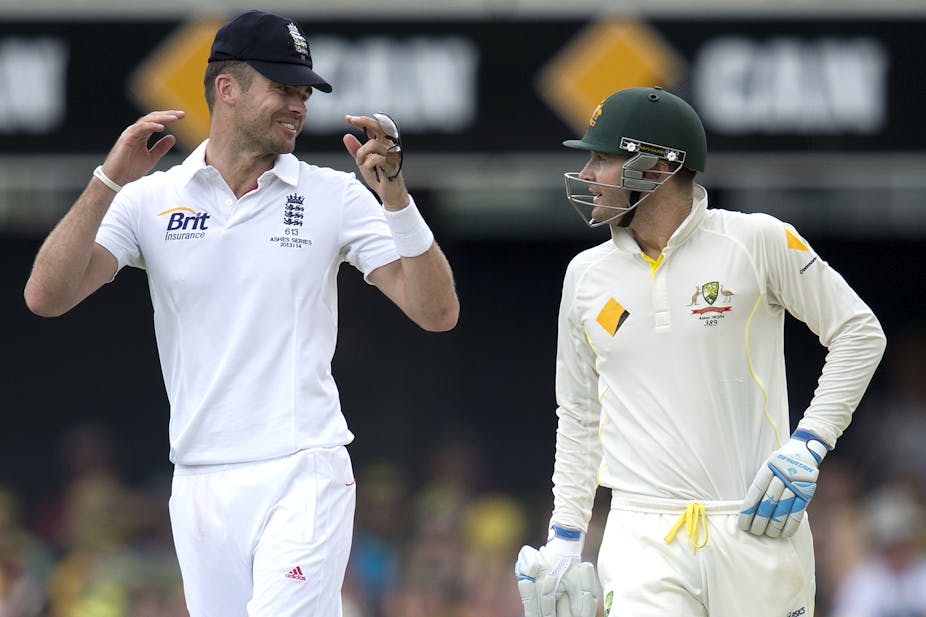Picture this scene: you and a colleague sit down for a meeting with your counterparts from another organisation. Before discussions begin, one employee leans over and questions whether you know what you are doing. They advise you to head for the door rather than face up to what the meeting will throw at you.
As discussions progress, another employee says that they have intimate knowledge of your partner and mother. Then, as negotiations reach a particularly important and delicate point, this employee threatens to “take your head off”. As negotiations are concluded everyone shakes hands and congratulates you on the job you did. You leave the building to a series of jeers and animated gestures from other workers.
In the workplace, behaviour that threatens the safety of another employee – or that questions the sexual morality of an employee’s wife or mother – would be classed as maltreatment. This behaviour would not be condoned and would be penalised.
Yet in sport, and particularly cricket, this form of behaviour, known as “sledging”, is not only condoned but celebrated as an important tool to use against your opponents. The acceptance of such behaviour raises questions about both the importance placed on sport and the treatment of those who play it.
Sledging as maltreatment
Maltreatment is a term that refers to a range of behaviours that have the potential to result in physical injuries and/or psychological harm to a person. As an umbrella term, it encapsulates behaviours perhaps otherwise known as abuse, harassment and bullying.
Maltreatment can include physical, psychological and emotional behaviours as well as neglect. Athletes, spectators and coaches all have the potential to be the victims and/or perpetrators of maltreatment in this context.
Sledging is a clear example of inter-player maltreatment in sport that can pose a significant threat to the well-being of the individual. This form of maltreatment can be direct or indirect and relates to verbal interaction between players on the field of play or in reference to players through media or other channels.
Sledging in focus
While sledging is not a new development, it was brought into focus at the end of the first Ashes Test match, after it was announced that English batsman Jonathan Trott was leaving the series due to a stress-related illness.
Trott was the target of off-field sledging by Australia’s David Warner, who described his performance – via the media – as “pretty weak”. This is an example of direct emotional maltreatment, targeted at a particular player, which has the potential to be harmful to the well-being of the individual. While England coach Andy Flower described Warner’s comments as “disrespectful”, he said it did not play a role in Trott’s decision to return home.

Towards the end of the match, England’s James Anderson is alleged to have threatened to punch Australian George Bailey. Australian captain Michael Clarke was overheard via on-pitch microphones suggesting that Anderson should “get ready for a broken fucking arm”. Following the match, Clarke was fined 20% of his match fee for the sledge.
Both of these are examples of direct physical maltreatment through the threat of physical violence with an aim to evoke fear or alarm in the opponent.
When this hostility/violence is committed by someone such as Clarke – who is in a role described by then-prime minister John Howard as the most important job in Australia – there are worrying consequences.
Sportsmen and women are commonly selected as role models or heroes. Countless young children look up to and aim to replicate the on and off-field behaviours of these athletes. Clubs and merchandising companies are happy to exploit this desire to copy through the use of athlete endorsers to sell not only sports-related goods but items from all realms of popular culture.
While it may be beneficial for fans to copy the onfield sporting exploits of these role models, it is concerning if the forms of maltreatment witnessed recently are also being copied.
Sporting organisations, especially when they are the employers of the athletes being maltreated in this way, should consider whether they are protecting the rights and welfare of their employees or whether their passivity is allowing this behaviour to continue.
Not just sledging of concern
It seems sledging is simply another example of the growing moral decline in sport and joins an increasing number of abusive incidents that have recently been highlighted within the media. These include instances of bullying or physical, emotional and sexual abuse of athletes.
Many of the more subtle examples of maltreatment such as sledging or inter-player maltreatment escape scrutiny because we believe them to be a “normal part of the game”. The distancing or normalising of behaviours clearly reduces any moral obligation to “care for athletes” or afford them the protection that would be expected as standard in other settings.
It is not acceptable to excuse this behaviour. Instead, it is time to accept that maltreatment would not be condoned in any other area of society, and therefore has no place on the sports field.

